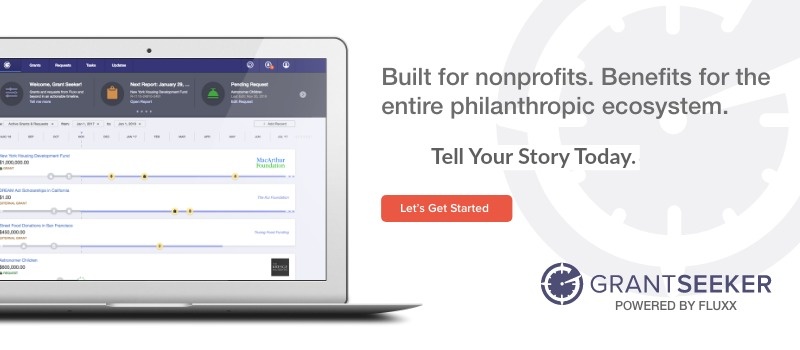
While it’s true that some grants come with strings attached, diversifying your nonprofit income with awards from private, corporate, or government-funded foundations can help you build a more sustainable fundraising strategy for your organization.
Even if giving is currently robust, relying solely on board giving, major and individual donors, or event revenue can disrupt your cash flow over time. Instead, your aim should be to locate funding from a diverse range of sources, in order to guard against potential budget shortfalls or a sudden flux in the economy.
According to the Spring 2017 State of Grantseeking Report, 75 percent of organizations that submitted just one grant application won an award. Of course, submitting proposals regularly and – over time – increases your chances with a funder, too. Most importantly, a high success rate with grant proposals both opens the door to future funding and cultivates interest from other funders. And that’s the kind of long-term support you need to grow.
Here are four more reasons you should incorporate grants as an essential part of a balanced revenue stream:
- Foundation giving is on the rise.
The most recent statistics from Giving USA show a steady uptick in charitable giving, especially for organizations working in international affairs, education, and the arts.
“There’s a lot of money out there,” confirms Marc Koenig at Nonprofit Hub. “Over $50 billion dollars are awarded every year through foundations. If you aren’t applying for a piece of the pie, that’s money left on the table—or being given to other organizations,” he adds.
But just because more foundations are giving doesn’t mean your organization can afford to phone in a grant proposal. Grants are awarded as a result of well-planned, well-written, and well-packaged proposals that address the missions of both your organization and the funder.
Include a compelling needs statement, demonstrate the expertise of your nonprofit, and provide a strong evaluation plan to catch the funder’s eye.

- There is a funder for every nonprofit.
Most development directors will cultivate the form of revenue that works best for their organization. For example, if your nonprofit receives most of its revenue from individual donations or major donors, it’s natural for your development team to put the most work into those giving areas.
Even so, neglecting grantseeking means you may miss out on opportunities to make connections with donors that can add multi-year support to your bottom line. Rest assured, there is a funder for every nonprofit.
“It’s simply a matter of whether you’re willing to research and connect with the right funders,” suggests Koenig.
“While project-specific funding is most common, it isn’t the rule. There are grants that exist to provide funding for capital campaigns, operational costs, endowment funding and even unrestricted funding.”
Grantseekers are most successful when they cultivate relationships with funders that are excellent matches for their programming. Evaluate your grant prospects carefully to make sure the lengthy process is worth it for you and your team. Before applying, ask yourself the following:
- Does this funder support our vision, or our specific type of programming?
- Is this enough money to make a significant impact on our programs or community?
- Is this a relationship that we can cultivate to open doors to more funding?
- Do we have the resources to carry out the program and the reporting requirements?
To make grant writing worthwhile, you must prioritize the relationships with funders that will support the growth of your organization above funders who might not quite be a good fit.
- A shifting political landscape creates uncertainty.
As anyone who depends on funding from the National Endowment for the Arts or the National Endowment for the Humanities understands, government funding of programs you care about will feel pinched due to shifting budget priorities at the federal level.
Use moments of economic or political uncertainty as an opportunity to review how well you’ve diversified your nonprofit income. Do you have a healthy mix of private, community, and corporate foundations in your prospecting list?
If your mission focus is targeted for cuts under the federal budget, shifting your attention to other sources of funding might serve you well as you weather the storm.
- Individual donors can be fickle.
Although individual small and major donors may be motivated and energized at the moment, as the winds shift, so might their priorities. Regardless of political affiliation or economic stability, major donors and individual donors can move on or scale back regular donations at any time.
This can leave development directors at smaller organizations feeling like they have to “chase the money.” Don’t. Seek out mission-driven institutional grantmakers instead. These funders make great assets because they think in the long-term, including committing deeply to a community’s particular needs or providing a wealth of resources to an organization over time.
Support from large institutional grantmakers can arrive in the form of multi-year grants, capacity building grants, or even meaningful organizational and individual relationships. Cultivating these large grantmakers can result in everything from small individual donations to board member connections or professional development opportunities—all of which contribute to your organization’s long-term growth.
Developing a fundraising plan or cash flow projections for a nonprofit is no easy feat. Nothing about your budget is set in stone, including projections for grant proposals. And while the exact mix of funding streams for your nonprofit will vary from other nonprofits, the key to growth depends on finding the right balance of revenue for your organization. Even if you’ve developed a killer major and individual donor cultivation plan, most sustainable revenue mixes include grants from institutional funders that help fuel long-term growth and create stability. Diversify in order to make sure your pipeline stays full—and your projects stay funded.

Kristen Evans is a content strategist and critic with a background in nonprofit development. A former grant writer for 826 Boston, she's also written about publishing, television, and feminism for Brooklyn Magazine, The Los Angeles Times, LA Weekly, and NYLON, among other outlets.